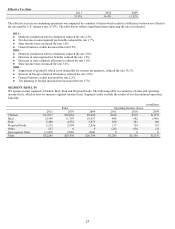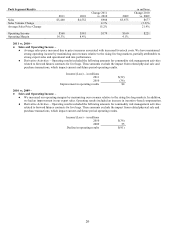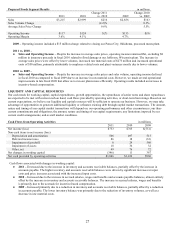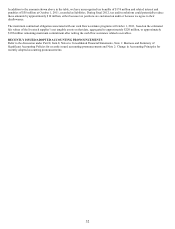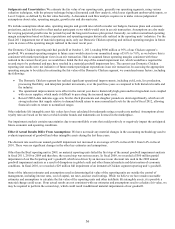Tyson Foods 2011 Annual Report Download - page 30
Download and view the complete annual report
Please find page 30 of the 2011 Tyson Foods annual report below. You can navigate through the pages in the report by either clicking on the pages listed below, or by using the keyword search tool below to find specific information within the annual report.
30
Liquidity
in millions
Commitments
Expiration Date
Facility
Amount
Outstanding Letters of
Credit under Revolving
Credit
Facility (no draw
downs)
Amount
Borrowed
Amount
Available
Cash and cash equivalents
$716
Revolving credit facility
February 2016
$1,000
$158
$0
$842
Total liquidity
$1,558
●
The revolving credit facility supports our short-term funding needs and letters of credit. Letters of credit are issued
primarily in support of workers’ compensation insurance programs, derivative activities and Dynamic Fuels’ Gulf
Opportunity Zone tax-exempt bonds.
●
Our 2013 Notes may be converted early during any fiscal quarter in the event our Class A stock trades at or above $21.96
for at least 20 trading days during a period of 30 consecutive trading days ending on the last trading day of the preceding
fiscal quarter. In this event, the note holders may require us to pay outstanding principal in cash, which totaled $458
million at October 1, 2011. Any conversion premium would be paid in shares of Class A stock. The conditions for early
conversion were not met in our fourth fiscal quarter of fiscal 2011, and thus, the notes may not be converted in our first
quarter of fiscal 2012. Should the conditions for early conversion be satisfied in future quarters, and should the holders
exercise their early conversion option, we would use current cash on hand and cash flow from operations for principal
payments.
●
We do not have any significant maturities of debt coming due over the next two fiscal years.
●
Our current ratio was 2.01 to 1 and 1.81 to 1 at October 1, 2011, and October 2, 2010, respectively.
Capital Resources
Credit Facility
Cash flows from operating activities and current cash on hand are our primary source of liquidity for funding debt service, capital
expenditures, dividends and share repurchases. We also have a revolving credit facility, with a committed maximum capacity of $1.0
billion, to provide additional liquidity for working capital needs, letters of credit and a source of financing for growth opportunities.
As of October 1, 2011, we had outstanding letters of credit totaling $158 million, none of which were drawn upon, which left $842
million available for borrowing. Our revolving credit facility is funded by a syndicate of 38 banks, with commitments ranging from $3
million to $90 million per bank. The syndicate includes bank holding companies that are required to be adequately capitalized under
federal bank regulatory agency requirements.
Capitalization
To monitor our credit ratings and our capacity for long-term financing, we consider various qualitative and quantitative factors. We
monitor the ratio of our debt to our total capitalization as support for our long-term financing decisions. At October 1, 2011 and
October 2, 2010, the ratio of our debt-to-total capitalization was 27.7% and 32.8%, respectively. For the purpose of this calculation,
debt is defined as the sum of current and long-term debt. Total capitalization is defined as debt plus Total Shareholders’ Equity. Our
ratio of debt to our total capitalization decreased in fiscal 2011 primarily resulting from reduced debt balances and increased retained
earnings associated with strong earnings in fiscal 2011.
Credit Ratings
2016 Notes
On September 4, 2008, Standard & Poor’s (S&P) downgraded the credit rating from “BBB-” to “BB.” This downgrade increased the
interest rate on the 2016 Notes from 6.85% to 7.35%, effective beginning with the six-month interest payment due October 1, 2008.
On November 13, 2008, Moody’s Investors Services, Inc. (Moody’s) downgraded the credit rating from “Ba1” to “Ba3.” This
downgrade increased the interest rate on the 2016 Notes from 7.35% to 7.85%, effective beginning with the six-month interest
payment due April 1, 2009.
On August 19, 2010, S&P upgraded the credit rating from “BB” to “BB+.” On September 2, 2010, Moody’s upgraded the credit rating
from “Ba3” to “Ba2.” These upgrades decreased the interest rate on the 2016 Notes from 7.85% to 7.35%, effective beginning with
the six-month interest payment due October 1, 2010.
On February 24, 2011, S&P upgraded the credit rating of these notes from “BB+” to “BBB-.” On March 29, 2011, Moody’s upgraded
our credit rating from “Ba2” to “Ba1”. These upgrades decreased the interest rate on the 2016 Notes from 7.35% to 6.85%, effective
beginning with the six-month interest payment due April 1, 2011.
A further one-notch upgrade by Moody’s would decrease the interest rates on the 2016 Notes by 0.25%, while a one-notch downgrade
by either ratings agency would increase the interest rates on the 2016 Notes by 0.25%.





